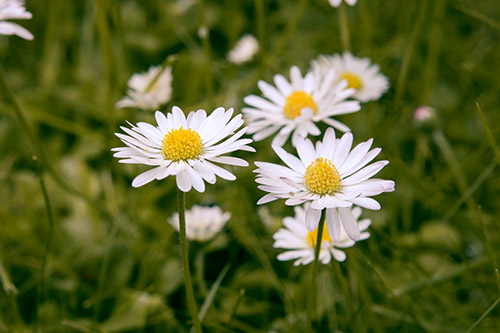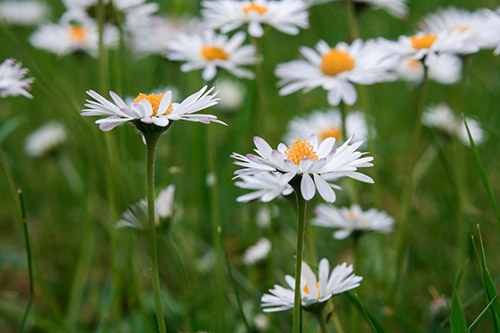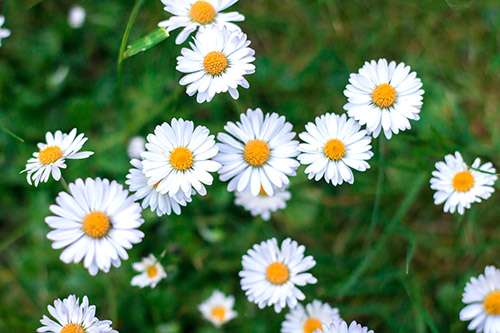The daisy is a familiar sight at this time of the year in the UK, popping up in lawns and on grass verges. Their proliferation, particularly on lawns, makes them an unwanted plant for some gardeners.
The flowers, or Bellis perennis, are also known as bairnwort, bruisewort, common daisy, English daisy, garden daisy, and wild daisy (Dietz 2020: 38).
Having multiple names for the same plant makes it awkward when looking at a Language of Flowers dictionary. The 1867 edition of Mrs Burke’s dictionary explains that daisies mean “innocence”, garden daisies mean “I share your sentiments” and wild daisies mean “I will think of it” (Burke 1867: 19).
The name ‘daisy’ is believed to come from ‘day’s eye’ since the flowers open according to daylight (Gray 2015: 78). Geoffrey Chaucer called it “the Eye of Day”, while Ben Jonson called them “bright Daye’s-eyes” (Ellacombe 1884).
Yet they’re more often associated with love, childhood, and divination! Let’s look at the folklore behind daisy chains, pulling petals, and trampling on daisies.
Daisies and Christianity
People believed the tips of the common daisy were pink thanks to the Virgin Mary. According to legend, she was gathering daisies for Christ when she pricked her fingers (Baker 2011 [1969]: 49).
Henry Ellacombe notes a link between the daisy and St Margaret, although this is more likely due to the daisy’s alternative name of ‘Herb Margaret’ (1884). The flower’s French name is ‘Marguerite’, which could explain this connection. In one depiction in a late fourteenth-century English Hours, St Margaret of Antioch wears a leather girdle decorated with daisy-like clasps (Dresvina 2016: 190).

Elsewhere, borders of daisies surround images of her, or she’s shown alongside the flowers. Juliana Dresvina does note that daisies were popular embellishments in manuscripts so it’s hard to tell if they were used specifically to refer to St Margaret, or if they were simply decorative (2016: 187).
The ox-eye daisy (Leucanthemum vulgare) is associated with St Mary Magdalene, which explains its alternative name of maudlinwort. It was also sacred to St John the Baptist since it blooms around the summer solstice.
The Michaelmas daisy (Aster amellus) was named for St Michael.
The Daisy Chain
I’m sure we all made daisy chains as children. You simply picked plenty of daisies, split the stem, and threaded the next daisy through the slit! Such simple fun. Christina Oakley Harrington notes the importance of the daisy chain in Somerset and Devon to protect a child from being kidnapped by fairies (2020: 52).
This adds an extra layer of nuance to an otherwise innocent pastime.

Despite this tendency to pick daisies to make chains, there was also a downside to this. Children who stood on or pulled up daisies would suffer poor growth (Baker 2011 [1969]: 49).
Though there is a more distressing link between daisies and children. In some folklore, daisies were believed to be the spirits of children who died during or soon after birth. The flowers sprang up to comfort their parents, which could explain why they’re associated with innocence (Gray 2015: 78).
The association between daisies and children might explain why it was apparently called “bairnwort” in the north of England, with bairn being our word for ‘child’ (Ellacombe 1884).
Love Divination and Magic
The other common link for daisies is with love, which is hardly surprising since Culpeper attributed the plant to Venus (Harrington 2020: 51). Women apparently decorated their hair with daisies, further linking the daisy with youthful beauty (Gray 2015: 78). Think of that next time the supremely annoying advert for the Daisy fragrance by Marc Jacobs comes on TV.
But the daisy is strongly associated with the love divination that involves plucking the petals, saying “he loves me, he loves me not” (Gray 2015: 78). The answer was whichever part of the charm you landed on for the final petal. It does appear with other plants, but it’s most often linked with daisies.
Some think that the plucking game actually began with the ox-eye daisy, but the common daisy became more popular since they’re easier to find (Wildlife Trusts n.d.). You’re also not plucking petals, but individual flowers! Daisies have composite flower heads, so each head is made up of lots of tiny flowers.
Margaret Baker gives an alternative love divination involving daisies. Rather than picking petals to determine if a lover actually loves the picker, girls might also pick a bunch of daisies. The number of flowers in the bunch showed the number of years until her wedding (2011 [1969]: 49).
Daisies also appear in love magic. Keeping a daisy root beneath your pillow was believed to bring back straying lovers (Dietz 2020: 38). Christina Oakley Harrington notes a Somerset charm in which it was ox-eye daisies used to encourage an unfaithful lover to come back (2020: 52).
Meanwhile, wearing a daisy would help to bring you love – presumably with a faithful person! Whoever picked the first daisy of the season would be wildly flirtatious (Dietz 2020: 38).
Here in the UK, the daisy is apparently the flower of the fifth wedding anniversary.
The Myth of Alcestis
Daisies also appear in the myth of Alcestis, the daughter of King Pelias, although the association seems to be more recent than antiquity. Alcestis is a lofty figure in Greek literature, her hand in marriage having been won by Admetus (with help from Apollo). Unfortunately, Admetus forgot to make a sacrifice to Artemis, who cursed him to die. Apollo managed to convince the Fates to change the curse – but not end it completely. Admetus could live, but only if someone offered their own life on his behalf. At the fateful moment, only Alcestis tendered her life in exchange for her new husband.

In one version of the story, the gods are so moved by her sacrifice that they allowed her to return to earth – Persephone herself sends her back from the underworld. When the myth reached the Middle Ages, Chaucer associated her with the daisy in his Legend of Goode Wimmen (Blasone n.d.). A. C. Spearing suggests this explains the romantic symbolism of the daisy, representing “a human love which can conquer even death” (1976: 108).
It’s also odd since the ox-eye daisy is associated with Artemis (Evans 2014). I don’t know if Chaucer knows that, but it seems strange to turn Alcestis into the plant favoured by the goddess who cursed her husband. That said, daisies are sometimes referred to as moon daisies, and Artemis is the goddess of the moon, so perhaps it was simply the influence of Chaucer’s favourite flower.
Daisies and the Weather
There’s apparently an English saying that you know summer has arrived because you can put your foot on twelve daisies (Gray 2015: 78). According to Margaret Baker, the saying refers to spring, not summer (Baker 2011 [1969]: 49). Elsewhere, seven daisies are cited as being necessary (Botanical.com 1995-2021a). Whole clumps of them have come up where I live in April, so I feel like Baker might have won that one.
That said, because daisies are still blooming in summer when thunderstorms are more common, in some places they’re called ‘thunderflowers’ (Gray 2015: 78).
The seasons also impacted what daisies meant when it came to dream lore. Dreaming of daisies during the spring or summer meant good luck was coming. Dreaming of daisies in autumn and winter predicted hard times (Gray 2015: 78).
Daisies and Remedies
There is less folklore about daisies than we saw with nettles, although like their stinging friends, daisies can be made into a tea. This apparently helps with bronchitis, coughs, and inflammation, though as always, check with a qualified herbalist first.
Some people also apply fresh daisies to the skin to help heal bruises, which explains its old name of bruisewort. Bearing in mind that arnica and daisies are both in the asteraceae family, and arnica has long been noted for its bruise-busting qualities, this may actually make some sense.

According to Henry Ellacombe, Pliny discussed the humble daisy, claiming it was an effective treatment for the King’s evil (i.e. scrofula) when made into an ointment with mugwort (1884). Scrofula is the inflammation of the lymph nodes in the neck, and if daisy does help with inflammation, then I can see the logic in this one.
In earlier times, people used common daisy to cure wounds, reduce liver inflammation, or combat gout (Botanical.com 1995-2021a). Meanwhile, the ox-eye daisy was believed to help with women’s complaints, perhaps due to its links with Artemis, the goddess of women. It was also used to treat whooping cough and asthma (Botanical.com 1995-2021b).
What do we make of daisies?
For such a prolific and recognisable plant, it’s somewhat surprising that daisies appear less in remedies than something like dandelions. Instead, we see them more often associated with childhood games and love divination.
Perhaps the fact that they’re so prolific is a good sign when it comes to looking for love, especially when it feels like love is a little thin on the ground!
Remember, they’re great for pollinators, and a lawn without them might look tidier, but they’ll also cheer up your garden.
Do you like the humble daisy? Let me know below!
References
Baker, Margaret (2011 [1969]), Discovering the Folklore of Plants, third edition, Boxley, Oxford: Shire Classics (aff link).
Blasone, Pino (no date), ‘On the Traces of Alcestis’, Academia.edu, https://www.academia.edu/1079454/On_the_Traces_of_Alcestis.
Botanical.com (1995-2021a), ‘Daisy, Common’, Botanical.com, https://www.botanical.com/botanical/mgmh/d/daisyc03.html.
Botanical.com (1995-2021b), ‘Daisy, Ox-Eye’, Botanical.com, https://botanical.com/botanical/mgmh/d/daisyo04.html.
Burke, Mrs L. (1867), The Illustrated Language of Flowers, London: G. Routledge & Co.
Dietz, S. Theresa (2020), The Complete Language of Flowers: A Definitive and Illustrated History, New York: Wellfleet Press (aff link).
Dresvina, Juliana (2016), A Maid with a Dragon: The Cult of St Margaret of Antioch in Medieval England, Oxford: Oxford University Press.
Ellacombe, Henry Nicholson (1884), The Plant-Lore and Garden-Craft of Shakespeare, London, W. Satchell and Company.
Evans, Paul (2014), ‘The daisy, the spider and the damselfly’, The Guardian, https://www.theguardian.com/environment/2014/jun/10/daisy-spider-and-damselfly.
Gray, Samantha (2015), The Secret Language of Flowers, London: CICO Books (aff link).
Harrington, Christina Oakley (2020), The Treadwell’s Book of Plant Magic, London: Treadwells Books.
Spearing, A.C. (1976), Medieval Dream-Poetry, Cambridge: Cambridge University Press (aff link).
Wildlife Trusts (no date), ‘Common daisy’, Wildlife Trusts, https://www.wildlifetrusts.org/wildlife-explorer/wildflowers/common-daisy.
Nutty about folklore and want more?
Add your email below and get these posts in your inbox every week.
You'll also get my 5-step guide to protecting your home using folklore!











Hello Icy, I’m new to your website and creations, and the first invitation to your content was to this article/podcast. I thought it was really interesting and I chose to read along with the podcast, so that I could see how certain names are spelled and to also have a look at the accompanying pictures. So far, I’m enjoying what you have to offer, and I look forward to more of your stories. Thanks!
Hi Icy, I’m your fan living in Denmark, so my very American love of cheerful daisies is shared on en even higher level by the rest of the gang because, the much admired & loved queen is Margrethe, whose name is a variation on Marguerite & who is affectionately known as Daisy. She is often seen sporting daisy broches or earrings & as soon as spring arrives in the Frozen North there are potted daisies for sale. In my desert home of Tucson, Arizona we had mainly colorful African daisies that could take the dry heat. Again, I love daisies & enjoyed this episode lots!